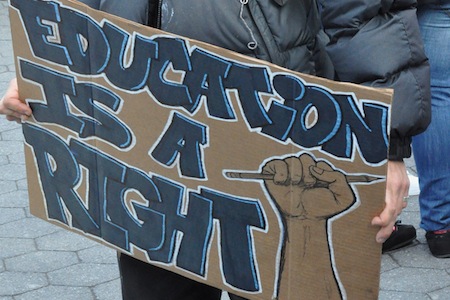School Closings and Public Policy

Sign at an "Occupy the Schools" rally in New York City last February. Credit: Flickr/Michael Fleshman.
School closings, the threat of which hang over Chicago public schools, and which have been a central feature of Bloomberg educational policies in New York, are perhaps the most controversial features of the Obama administration’s “Race to the Top” initiative. The idea of closing low-performing schools, designated as such entirely on the basis of student test scores, removing half of their teaching staff and all of their administrators, and replacing them with a new (typically charter) school in the same building, is one which has tremendous appeal among business leaders and almost none among educators. Advocates see this policy as a way of removing ineffective teachers, adding competition to what had been a stagnant sphere of public service, and putting pressure on teachers in high-poverty areas to demand and get high performance from their students, once again based on performance on standardized tests.
For a “data driven” initiative, school closings have produced surprisingly little data to support their implementation. In New York City, there has been no perceptible decline in the test score gap between black and Latino students, and white and Asian students, since the school closings were initiated (more than one hundred forty schools in NYC have been closed). More tellingly, the percentage of black and Latino students in the city’s specialized high schools -- admission to which is based entirely on test scores -- is the lowest in the city’s history, prompting a lawsuit from the NAACP.
But the opposition to the closings is not just based on lack of “hard” evidence to support their implementation. It is based on three broadly observed consequences of the closings -- their propensity to ignore the voices of students, parents, and teachers and ride roughshod over the democratic process; their creation of pressures which transform teaching into test prep and lead to the elimination of art, music, physical education and school trips; and the destabilizing of already wounded neighborhoods by undermining relationships between schools and communities and teaching staffs and families.
In New York City, where school closings have been public policy for more than four years, I know of no example where parents and students have mobilized to demand the closing of a troubled school, but many instances where they have mobilized to oppose school closings. With few exceptions, their voices have been ignored by the Panel for Education Policy, the Bloomberg-controlled arbiter of school closing decisions. Test scores and Department of Education recommendations have ruled the day. With the elimination of local school boards and the imposition of mayoral control, there is no institutional channel that has any power to represent community interests. Children and parents are being taught a devastating lesson here -- that their voice doesn’t count. Only those who think the goal of public education is to create a passive, disciplined labor force will to accept any work offered to them should take comfort in this.
A second, even more devastating consequence is how the threat of school closings ratchets up stress levels in low performing schools. Not only has this led to epidemics of clinical depression among teachers and stress-related disorders in children, it has led many schools to drastically transform their curricula to assure students pass tests. First to go are art, music, hands-on science and school trips; but there have also been many instances where gym, recess, and after-school programs have been reduced to make room for test prep, magnifying already serious obesity problems among children in places like the Bronx where there is little access to healthy food and few out-of-school opportunities for regular exercise. The conditions I have described, in some schools, have reached levels which could best be described as child and teacher abuse. It is time that those making these policies take responsibility not only for what happens when schools close, but the kind of pedagogy schools in high-poverty neighborhoods implement to assure that they won’t be closed.
Finally, there is the issue of neighborhood stability. In poor neighborhoods, it is common for young people to move from household to household, sometimes from household to shelter, in response to the economic instability of their caregivers. Many children are being brought up by grandparents or other relatives; some are in foster care, some are homeless. In this situation, schools are often the main point of stability in children’s lives, and teachers important mentors. I know of many teachers in these communities who financially support their students, take them on trips, sometimes have them come to their home on weekends. Closing schools and removing teachers undermines the critical community building function of public schools, leaving young people without an important anchor in their lives. Given this, no one should be surprised by rising levels of violence in communities where this policy is being applied. We need schools in such communities to be safe zones -- not places of fear and dread where everyone involved is waiting for the hammer to fall on the instruction of someone downtown who has no idea what people in the neighborhoods are living through and often just doesn’t care.
I urge all who have read this piece to think very carefully whether school closings are in fact an instrument to promote greater equity or whether they intensify the problems they were meant to remedy and create new problems in their wake.
